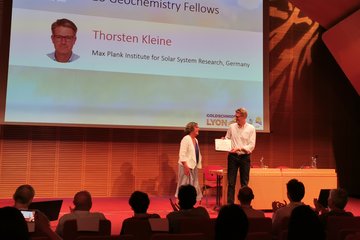Alle Typen
101.
Zeitschriftenartikel
A partial reflection experiment using the FM-CW technique. Radio Science 11, S. 1009 - 1018 (1976)
102.
Zeitschriftenartikel
Partial reflection measurements with FM-CW - A preliminary investigation. Zeitschrift für Geophysik 38, S. 953 - 957 (1972)
103.
Buch
Images of the nucleus of Comet Halley. ESA Publ. Div., Noordwijk (1995), 254 S.
104.
Buchkapitel
14 - OSIRIS: The Scientific Camera System Onboard Rosetta. In: ROSETTA ESA's Mission to the Origin of the Solar System, S. 315 - 382 (Hg. Schulz, R.; Alexander, C.; Boehnhardt, H.; Glassmeier, K.-H.). Springer Science+Business Media, New York (2009)
105.
Buchkapitel
Imaging technique of the DISR camera on the Huygens lander. In: Scientific Detectors for Astronomy 2005, S. 199 - 204 (Hg. Beletic, J. E.; Beletic, J. W.; Amico, P.). Springer, Dordrecht, The Netherlands (2006)
106.
Konferenzbeitrag
A Marconi CCD42-40 with anti-blooming - Experiences with the OSIRIS CCDs for the ROSETTA mission. In: Scientific detectors for astronomy - The beginning of a new era, S. 131 - 135 (Hg. Amico, P.; Beletic, J. W.; Beletic, J. E.). Kluwer Academic Press, Dordrecht, The Netherlands (2004)
107.
Konferenzbeitrag
CCD's for the Rosetta Science Imaging System OSIRIS. In: Optical Detectors for Astronomy II, S. 55 - 62 (Hg. Amico, P.; Beletic, J. W.). Kluwer Acadmic Press, The Netherlands (2000)
108.
Konferenzbeitrag
The Robotic Arm Camera for the Mars Volatile and Climate Surveyor. In: Planetary Systems: The Long View, S. 271 - 272 (Hg. Celniker, L. M.; Vân, J. T. T.). (1998)
109.
Konferenzbeitrag
The imager for Mars Pathfinder (IMP) experiment. American Journal of Physics, S. 1062 (1996)
110.
Konferenzbeitrag
'LASCO' - A wide-field white light and spectrometric coronagraph for SOHO. In: The SOHO Mission, S. 55 - 61. ESA Publications Division, ESTEC, Noordwijk, Holland (1989)
111.
Konferenzbeitrag
An FFT method to optimise the removal of coherent noise in small and large images. In: Image Processing II, S. 180 - 184. (1988)
112.
Konferenzbeitrag
The dynamic range of individual images improved by cross-correlation. In: Image Processing II, S. 174 - 179. SPIE (1988)
113.
Konferenzbeitrag
Video of Giotto's encounter with comet P/Halley. In: Dust in the universe, S. 161 - 167 (Hg. Bailey, M. E.; Williams, D. A.). Cambridge University Press, Cambridge (1988)
114.
Konferenzbeitrag
Restoration and enhancement of cometary images taken by the Halley Multicolour Camera. In: Proceedings of the 13th annual conference of the remote sensing society. Univ. of Nottingham, Nottingham (1987)
115.
Konferenzbeitrag
Observations by the Halley multicolour Camera. Proc. 20th ESLAB Symposium on the Exploration of Halley's Comet (ESA SP-250, vol. II), S. 347 - 350 (1986)
116.
Konferenzbeitrag
Optimization, test and calibration of the Halley Moulticolour Camera CCD detectors. ESO Conference and Workshop Proceedings (25), S. 115 - 124 (1986)
117.
Konferenzbeitrag
Detailed analysis of a surface feature on comet Halley. In: Proc. 20th ESLAB Symposium on the Exploration of Halley's Comet, Heidelberg, S. 371 - 374. (1986)
118.
Konferenzbeitrag
Getting more by taking less: A method of summing up pixels on a CCD imager. In: Advances in Electronics and Electron Physiks, S. 193 - 203. Academic press, Inc., London (1985)
119.
Bericht
Benefit from annealing proton irradiation defects on the OSIRIS CCDs. Max-Planck-Institut für Aeronomie, Katlenburg-Lindau, Germany (2003)
120.
Bericht
Performance degradations observed on scientific CCD imagers from Loral with erratic substrate grounding. Max-Planck-Institut für Aeronomie, Katlenburg-Lindau, Germany (1994)











